June 2008 archives
you are here [x]: Scarlet Star Studios > the Scarlet Letters > June 2008
<< before
May 2008
after >>
July 2008
June 27, 2008
our house is red and purple!
by sven at 10:58 pm

We've painted the house... Now it's red and purple!
The house was built in 2000, and due for recaulking and repainting. At last: our opportunity to get rid of that horrible, bland gray!


Selecting the colors was nerve-wracking. I spent hours and hours sitting on the corner across the street, holding up paint chips, trying to visualize the possibilities. Paint colors are like house guests... I really wanted to get to know the folks who'd be coming to stay with us -- intimately -- before they moved in.


As the first coats of "caliente" red started going up, the neighbors were dubious. They'd drive around the corner slowly, and shout questions out their car windows:
"Did you pick that color yourself?"
Yes.
"It's... Bold."
But, as the "kalamata" purple peaks and "aplomb" lavender trim started going up, I sensed people starting to warm to it. The best comment we got: "I like the color! The less beige in this neighborhood, the better!"
Amen, brother!


Most of the houses in this neighborhood were built all at the same time. Block after block of gray, pale tan, pale yellow, white trim... They're all going to be needing new coats of paint pretty soon. We're more or less the first to repaint -- and it would delight us to no end if it our "bold" choice inspired others to also get a little daring.

Besides wanting delicious new colors, we also decided that we wanted to go Earth-friendly. The paints that we used are from the Benjamin Moore "Affinity" line. They're a bit more expensive... But they're low VOC (volatile organic compound), last extra long, and are extra resistant to fading.
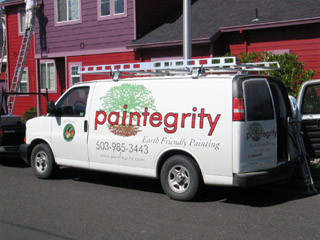
The paint job was done by Paintegrity -- whom we have nothing but praise for.
- they specialize in Earth-friendly house painting
- they did the whole job in just five days (!!)
- they took care to do a good caulk job (almost more important than the paint)
- they were exceptionally detail-oriented
- they gave everything at least two coats of paint, to guarantee durability
- they didn't leave behind any mess at all
- good, decent people -- pleasant to have around
I'd be happy to send more business their way... They're the kind of group that I really want to see stick around and flourish.
posted by sven | permalink | categories: studio space
June 24, 2008
keeping the computer cool
by sven at 8:00 am
This is another "B project" that I did recently while waiting for some animation to render.

Last year, when the weather got hot, Gretchin helped me by setting up some fans pointed at my hard drives. The boxes that the fans have been standing on were a bit precarious, so I finally went ahead and built little wooden tables to replace them.
Ah! Much less prone to being accidentally kicked over. :D
posted by sven | permalink | categories: studio space
June 23, 2008
paintbrush holder
by sven at 9:42 pm
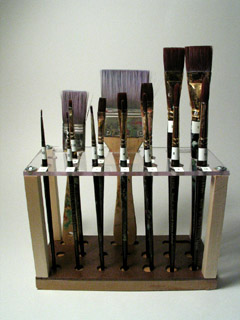
Two weeks ago I built this paintbrush holder. While I'm waiting for animation to render, sometimes I use the time to work on a "B project." This project was one of those.
The top is made of clear acrylic. There are divots in the base to help keep the brushes from sliding out of place.

And yes, I've put matching labels on the brushes and in front of their respective holes. Anal? Well...
Toward the end of Monster Month 2007, I decided that I wanted to invest in a bunch of decent brushes in different sizes, but all of the same brand (Winsor Newton). Prior to this, I'd been using a completely random array of brushes...
I want to move in the direction of understanding what distinguishes one brush from another. Making a holder that forces me to think about what brush I'm reaching for is part of this process.
posted by sven | permalink | categories: other art, painting
June 13, 2008
just make what you like?
by sven at 2:22 pm
[from an email to some artist friends]
"Just make what you like!"
You'd think that's all there is and all there could be to making art... But actually, the more I think about it, that's not what I want to do!
While journaling today, I came up with this thought: I want to explore beyond "what I like," discovering original, unexpected material.
I'm an artist/filmmaker who's very oriented toward process. To an extent, I'm more interested in creating an interesting Process Plan than a perfect Product. When I design a process, I can't guarantee that I'll love what evolves -- but I trust that by the end something unexpected and intriguing will emerge.
You might not immediately know what I'm talking about.... Here's an example of one possible process:
Go on a walk through your neighborhood and write down all the nouns you see. Come home, select your favorite words from the list. Write a poem that makes use of those words. OK, now stand up and move around... Make five full-body gestures that embody the idea of the poem. Got that? OK, now string them together in a sequence (with segues) to make a dance. Next, keeping your dance in mind, take 15 minutes to write a short story that's inspired by the motions you went through. And finally: Make a quick stopmo film of that story using rough-hewn puppets, sets made from painted cardboard "flats," and pop-through animation.
A little crazy... But you can see how repeated transformations are going to lead you somewhere that you never expected to go. And each of the steps in this Process Design is simple enough that you could get through the whole thing in just a couple of days, if you really push.
Go through a process like that ten times, and you'll have a collection of crappy little films that are punctuated with moments of pure genius. NOW you're ready to sift out the gems and assemble something that you could really love!
...Anyway, that's what I'm chewing on today. :P
posted by sven | permalink | categories: writing
June 8, 2008
studio shelves
by sven at 7:00 am
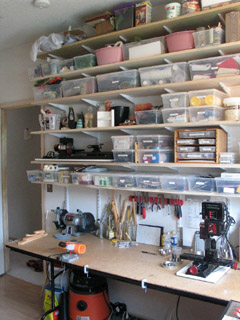
Two weeks ago, while waiting for a big render to finish, I finally got around to building shelves for my studio room.
At last, everything is off the floor and easy to find. I've put all my tools and art supplies into stackable clear plastic bins -- and labeled the bins. What a pleasure!
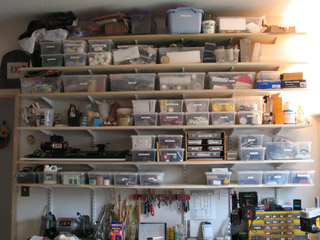
The shelves are 8 feet wide, 12 inches deep, poplar wood. The ceiling is 9 feet up, so I need a little step ladder when I want to get things down from the top.
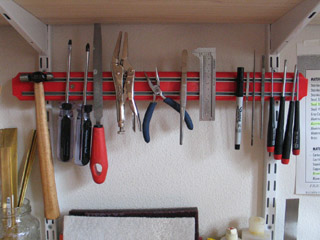
A related project: I installed this magnetic tool rack to organize my most frequently used hand tools. The rack is store-bought -- but in order to make it hangable, I had to engineer little brass brackets protruding from a piece of scrap wood. I'm pretty pleased that it worked.
posted by sven | permalink | categories: studio space
June 7, 2008
clown classes update
by sven at 4:40 pm

The clowning classes I was taking from Barnaby King have basically wrapped up. There's talk about doing a performance sometime in August... But I'll believe it when plans are a bit more concrete.
I've learned so much from these classes. This particular school of clowning is probably not what you'd expect... There's essentially zero discussion of gags, slapstick, and physical comedy. Instead, the classes have been all about finding an emotion, amplifying it, connecting with the audience, and sharing your moment-to-moment experience. That's stuff that's relevant to stopmo, theatrical acting, and novel-writing as well as clown.
Outside of the class, I found myself writing copiously in my journal, trying to digest the ideas. At the end of the main sequence of classes, I formatted all this text into a 46-page booklet/zine as a gift for my classmates and teacher. And still I find myself writing more.
The mask you see above was a project from one of the weekend intensives. It was a neat process. We sculpted lumps of clay with our eyes closed, then papier mached over the forms to make a mask. Painting was a similarly intuitive process, where we felt the shape with our eyes closed, and found all the areas that should be red, all the areas that should be orange, and so on... The product: A mask that we perform in just once, for the purpose of adding a new emotional color to our personal palette.
Barnaby's going to be moving to Chicago at the end of the summer -- but before he goes, there's going to be one more weekend class on August 9 & 10. For anyone who has an interest in performance -- in any style -- I can't recommend this class highly enough!
posted by sven | permalink | categories: classes & workshops
June 6, 2008
book review: a writer's guide to fiction
by sven at 3:12 pm
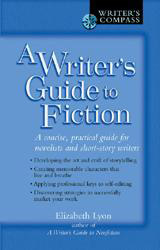
I'm afraid I'm going to damn Lyon's book with faint praise. I don't want to be unfair: It's OK... I found a certain usefulness in it... But there's nothing interesting enough about it that I think I'd ever tell someone to go read it. It's competently written -- but nothing more special than that.
A GENERIC SURVEY
Lyon lays out the various elements that go into creating a written story: plot, characterization, character arc, beginning with a hook, ending with a neat conclusion, making prose active and vivid... Topics that I'd expect anyone writing a book on fiction to cover.
The trouble is that I don't see any original thought in this book at all. Based on the copious references that Lyon lists, I'm convinced that she's probably read most of the better contemporary books about writing fiction... And this is the one real usefulness that I find in her book: I feel like without having to read them all myself, I've gotten a snap-shot of what people who think about the writing process currently believe.
Unfortunately, I find myself rather appalled at what "most people" (if that's really the case) believe. Here are a few of the buzzwords that seem to be inescapable:
- The Hero's Journey: Joseph Campbell's concept, which exploded into the public consciousness largely due to George Lucas' intentional use of it in Star Wars... Employing this form seems to have become almost mandatory.
- Archetypes: Using Jungian concepts to define your characters... It's another outgrowth of Campbell's influence in the story-making industry.
- Character Arc: meaning that the protagonist has a "fatal flaw" in their personality -- which, by the end of the story, leads to a personal revelation -- which is also an important lesson for the reader... It feels like this idea almost boils down to "all good stories should have a moral at the end."
The Hero's Journey, Archetypes, Character Arc: these are all interesting forms to study, and potentially quite useful to the aspiring writer. What I object to is the implication that all good fiction MUST be based on these principles. No exceptions to the rules are discussed, no alternative options adequately explored. [With the minor exception of the derivative "Heroine's Journey."]
Furthermore, I chafe against such advice coming from authors who are merely pointing to the seminal works of others. Grandiose claims that "all" stories must include a certain structure could be forgivable -- IF you were yourself doing the hard work of producing an original analysis, rather than just jumping on the bandwagon along with a generation of authors who seem to all idolize the same gurus.
STRONGER MOMENTS
So, the title "A Writer's Guide to Fiction" feels about right. I feel like I got on a tour bus and Lyon was my guide, pointing to the major landmarks as we drove through the "land of writers." But I don't feel like we got much of a chance to get out of the bus and go look at scenery up close. Overall, a somewhat bland and safe ride.
There are a few moments when Lyons expresses her own convictions -- which stand out as being more memorable:
"Characterization, not plot, is the core of successful fiction." (p.6)
I don't feel this statement is true -- but it's an interesting position that she asserts. (Personally, I feel that both characterization and plot are important -- but that emotion/feeling is the beating heart of fiction.)
"In fact, in nearly every novel I have edited or critiqued in two decades, the protagonist has been the last character to emerge from the marble." (p.118)
Lyon repeats this idea several times, that authors tend to neglect developing their protagonist's characterization. Good observation, which I'll make a point to remember.
"I believe the synopsis is so important for staying on course that writers should not see the synopsis as optional in their planning." (p.159)
I've read several books which advise writing various sorts of mission statements for your project. Lyon emphasizes coming back the microcosmic rendition of your story repetitively, though, which I found noteworthy.
In general, "A Writer's Guide to Fiction" feels strongest to me where Lyon is covering topics that she has really grappled with personally -- rather than material that she's just teaching from her lesson plan.
She talks about having been in critique groups for many years -- and consequently, her chapter on diagnosing problems in your fiction and correcting them feels concrete and useful.
The book that she wrote prior to this one was titled "The Sell Your Novel Tool Kit: Everything You Need to Know About Queries, Synopses, Marketing, and Breaking In." Consequently, her chapter on marketing your manuscript also felt more succinct and informative than most of the others.
A FEW INTERESTING METRICS
It's not at all a focus of Lyon's book, but what was probably most fascinating to me was when she'd talk about what it takes to produce good fiction and then throw out some actual numbers. This may just be a quirk of my own, having an interest in metrics... But to the extent that I can say something positive about this book and not undermine your interest in it entirely, this seems worth mentioning. Here are some quotes that I latched onto to tickle your interest.
How long does it take to become a pro writer?
"Practice until you get your million words behind you--the number John D. MacDonald claimed were necessary to become a pro--and use your gut." (p.100)
"Donald Maass, an established and respected New York literary agent who is a former president of AAR and also, uniquely, a former published novelist, estimates ten years of diligent writing, study, and marketing as the average time it takes for a writer to reach professional skill. I agree." (p.229)
How long should I take to write a book?
"Phyllis Whitney, the famous writer with more than one hundred novels to her credit, described her ideal timeline and methods for writing a book as these: two months for research, including filling in characterization worksheets and blocking out her plot; two months for writing the first draft, according to a quota-per-day page count; and two months to revise and rewrite. Six months per novel." (p.125)
How many times should you revise a book?
"The successful and prolific writing couple, Dean Wesley Smith and Kristine Kathryn Rusch, tell writers to revise no more than three times. That advice is not based on the assumption that the writing reaches perfection after the third revision; it is instead based on the probability that the writing is not finished and won't come any closer to perfection or being publishable by more revision. Smith and Rusch maintain that writers need experience in generating words more than anything else to develop publishable skill. Novices need to write many pieces--hundreds of short stories or dozens of novels--rather than limit themselves to what they could learn by revising only one novel or a handful of stories. I've also heard Dean and Kris stir controversy by saying that any revision beyond three robs a piece of its vitality and freshness." (p.235)
"Mainstream literary novelist Jonis Agee combines hot writing with ongoing light revision, and she uses a method of writing that brought a collective gasp from her audience at a revison workshop she led at Pike's Peak Conference in 2002. When she finishes draft #1, she reads it all the way through, and then throws it away. She writes draft #2, finishes it, reads it all the way through, and then throws it away. She told the audience that it is her third draft when she feels like her writing is best, the emotions authentic, and the characters come alive. When asked, she said that at most, she might save twenty to fifty pages of the drafts she throws away." (p.155)
posted by sven | permalink | categories: writing
June 3, 2008
how to fail
by sven at 12:37 pm
Sometimes I find it useful to write myself reminder lists like this:
1. Success
Don't allow failure to be an option. Work yourself as hard as possible, no matter what the cost. Product is all-important; process doesn't matter. You can think about a sustainable lifestyle after the big job is done.
2. Quitting time
Don't have daily quitting times. Give the project everything you've got -- your first waking thought, your last moments before falling sleep... And let it hover in your subconscious with worry even while you sleep.
3. Time Goals
Don't set goals for how much time you're going to invest. Just work as hard as you can. Follow the level of motivation that you feel at the moment -- and if motivation is flagging, then berate yourself. Remember, if there's a set limit on how much time you're going to put in, then you might miss out on putting in a few more hours for your maximum possible output.
4. Calendars
Take one day at a time. Stop looking ahead on the calendar. Lose all sense of context. Let your time horizon narrow down to just this day, just this moment. Nothing matters except how good or bad you feel right now.
5. Other Responsibilities
Let go of all other responsibilities. Do nothing except this one project, day after day until it's done. When it's all over, you can catch up on bills, emails, dishes, relationships.
6. Planning
Don't spend any time planning -- looking at the calendar, collecting to-do lists, figuring out goals and plausible schedules. That takes away time that could be spent working productively.
7. Food
Snack on candy. Give yourself little treats for motivation and get into a cycle of mood crashes.
8. Sleep
Ignore sleep. Get into a habit of staying up late. Or repeatedly cheat sleep by going to bed late AND getting up early... That way you can develop a significant sleep deficit in just 2 or 3 days.
9. Alarm Clocks
Don't use an alarm clock. Just follow your body, going to bed when you're tired, and waking up whenever you do so naturally -- even if that's after noon. (And don't bother to keep notes tracking your sleep patterns.)
10. Exercise
Don't exercise. Stay glued to your chair until you start feeling chest pains. Instead of walking several times a day, wait until health becomes a crisis.
posted by sven | permalink | categories: writing
June 2, 2008
lsgl: rendering
by sven at 11:11 am
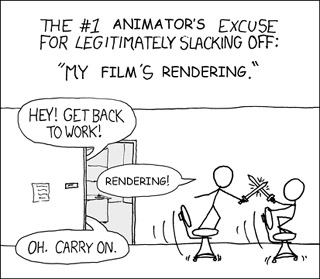
Day 38 in the 100-day countdown
I've finished rendering about 45 seconds of Let Sleeping Gods Lie's Act 2, which should be about 2 min long. Barring big problems, I should be able to get Act 2 done this month. Which means I can start worrying about whether or not I can finish Act 3 (already 80% complete) and get the sound done in time for the August 15 deadline. Things are hopeful: it looks like I have a decent chance of finishing this project! :D
But it's taking a toll. There are days when this film feels like a death march. It's not that I mind hard work -- hard work is satisfying when it gives a sense of control. The problem is that I don't feel like I'm in control of the film right now -- rather, it controls me.
For the first 50ish days of the 100-day countdown, I set myself a 25 hour per week goal -- and when I hit it, I could quit working on the film and do other projects. Now, it feels like I can't afford to ever stop; I simply have to put in as many hours as humanly possible. It makes me feel trapped.
Another facet of losing control is that right now I have these massive renders to output. I'll spend 2-10 hours preparing a file, and then it renders overnight, for 24 hours or more. That means I get a break... But when it's going to happen is unpredictable. So I can't anticipate it or relax when it happens. It feels like being on-call; a rhythm of life that I've seen folks in the medical profession go through, which has always seemed eviscerating.
This is just a hard part. It'll be fine... Despite what it feels like, this project will NOT last forever.
posted by sven | permalink | categories: let sleeping gods lie